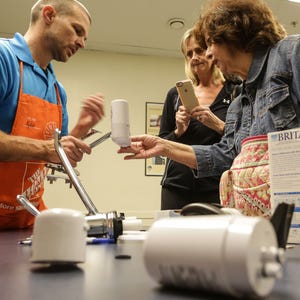 |
| Dan Wyant, Michigan Director of DEQ |
Dr. Mona Hanna-Attisha is a hero in more ways than one.
To begin, she was able to successfully introduce empirical science into Michigan child welfare policy making.
The numbers made the argument. As there is an increase in the levels of lead in the water, there is a direct and perfect correlation with cognitive and psychological developmental disabilities in children as well as an adverse effect in the economic well-being of the population. This is well documented, yet was blatantly ignored by the state. Here is why:
It almost seems the Department of Environmental Quality was creating conditions to solicit the federal government on securing funding to repair and update Flint's water system under a private contractor, but who am I to make such a sensational statement?
Medicaid in child welfare has no oversight mechanism and its billing is easily manipulated which makes this a political issue. Child poverty and its resulting disabilities maximize revenue for its privatized, not-for-profit programs under the Medicaid expansion.
There is no reason why DEQ could not confer with DHHS when issues dealing with the safety and well-being of children were raised and slammed on the table to be addressed by the Doctor and her team. These administrators need to be held accountable for intentionally allowing children of Michigan to suffer. There needs to be an investigation and public hearing to find out why this was allowed to happen.
Dr. Mona Hanna-Attisha uncovered another Medicaid fraud scheme in child welfare, and that is what makes her a real hero.
Flint doctor makes state tell lead truth
Voting is beautiful, be beautiful ~ vote.©
Dr. Mona Hanna-Attisha uncovered another Medicaid fraud scheme in child welfare, and that is what makes her a real hero.
Flint doctor makes state tell lead truth
Spokesman apologizes for questioning results
Under the steady gaze of a watercolor giraffe and tissue paper butterflies, a Flint pediatrician and mother of two last month forced the state of Michigan to snap to attention.
But getting the state to concede the probability that Flint's water is poisoning its children with lead —after months of assurances from both city and state officials that the water is safe — was far from easy.
It required Dr. Mona Hanna-Attisha, 38, to side-step bureaucracy. It meant awkward conversations and putting her hospital —city-owned Hurley Medical Center — smack-dab in a political minefield.
And it meant checking her data “a zillion times,” she said, then second-guessing herself to the point of being physically ill when a state spokesman questioned her credibility.
Just hours after state officials acknowledged her data, Hanna-Attisha felt equal parts exhausted and vindicated — at one moment laughing at congratulatory e-mails and comments from colleagues (Maybe they'll give you a lead key to the city, one had quipped), at another reciting sobering statistics about the life-long damage from lead poisoning: irreversible brain damage, development delays, speech problems, a boosted risk for behavioral issues, serious chronic conditions, to name a few.
"It has been such a physiologic response," she said of her look at the numbers and the state's reaction. She sat in her office, where children's artwork hangs haphazardly on the walls. A pink-lettered sign on her door — This is my fight song, it reads — pays homage to Hurley's youngest cancer patients.
"At times I want to cry and then I’m so happy," she said.
But then Hanna-Attisha,a pediatrician for many of Flint's poorest families whose training and experience has focused on environmental toxins and health disparities, shook her head.
"But then I’m tearful because how could this have happened in 2015 when all these regulations are in place (to ensure clean water)? For a population that has every burden in the world already, this is the last thing they needed," she said.
In retrospect, Attisha served as the canary in the coalmine in this latest public health crisis — the doctor who spotted a problem and wouldn't let it go until others paid attention, said Dr. Eden Wells, the state’s chief medical executive.
"She was a doc on the front lines who knows to pick up the phone ... rattle some cages and say 'Hey, come here, we’ve got a problem,'" Wells said.
It began over a dinner party with high school friends Aug. 26.
Among Hanna-Attisha's guests was a friend who played piano at her wedding and is also a water-quality expert. The conversation turned to the issue of the drinking water. Have you looked at kids' blood-lead levels? the friend asked.
Hanna-Attisha was not only intrigued, but also perfectly positioned for such a data dive.
She heads the pediatric residents program at Hurley and is a pediatrics and human development professor at the Michigan State University College of Human Medicine. She sits on the Michigan Chapter of the American Academy of Pediatrics, too.
In short, she lives as much on the research side of medicine as she does the clinical side.
So she knew that routinely drawn blood-led level data existed for thousands of Flint-area children, especially those on Medicaid or who live in high-risk areas for lead exposure. The following week, she turned to the Genesee County Health Department for its blood-lead level data.
She was disappointed. Test results are kept in individual patient files and could not be easily analyzed, Genesee County health officer Mark Valacak told Hanna-Attisha.
Undaunted, she asked the state for its analysis of the same blood-level data for Flint.
In the meantime, local and state officials were facing mounting pressure from residents who had already complained that the water smelled and tasted funny.
In mid-September, a Virginia Tech researcher and lead expert, Marc Edwards, concluded from his testing of Flint water it was 19 times more corrosive than Detroit water. And even though repeated testing at Flint's water treatment plant had detected no lead and testing in homes had registered lead at acceptable levels, according to the state, Edwards wrote on his web site, www.flintwaterstudy.org, that his own test results suggested an undeniable presence of lead in water drawn from Flint homes.
While she waited for state data, Hanna-Attisha began sorting through Hurley's own records — a total of 1,746 test results from Flint children to compare against 1,640 results from elsewhere in Genesee County. The results were sobering: The number of Flint children with elevated blood-lead levels — 5 micrograms per deciliter or more — jumped from 2.1% in the 20 months prior to Sept. 15, 2013, to 4.0% between Jan. 1 and Sept. 15 this year. In certain ZIP Codes, the change was even more troubling, she said — jumping from 2.5% of the children tested to 6.3%.
The change correlated roughly to the timing of the city's switch from using Detroit water to water that would be temporarily drawn from the Flint River.
She and her research assistant kept rechecking the numbers — often late into the evening.
One night, "her baby is crying and I’m like 'Can you run that p-value one more time?'" she said, chuckling.
By the time Hanna-Attisha went to Hurley's CEO, Melany Gavulic, public panic was high. Community organizations were handing out filters and bottled water. Community leaders blamed a state-appointed emergency manager for changing water systems. It's an election year too for the city.
It was a “politically messy situation,” Hanna-Attisha told her boss. Gavulic was clear, Hanna-Attisha said: Kids' health comes first.
On Sept. 24, Hanna-Attisha went public with her results.
The response from the state, she said, was startling. Her research was dismissed and her comments called "unfortunate."
Brad Wurfel, spokesman for the Michigan Department of Environmental Quality, repeated a familiar refrain: Repeated testing indicated the water tested within acceptable levels.
Hanna-Attisha said she crawled into bed that night, physically ill.
"We checked our data a bazillion times ... but when you hear (the state's dismissal) on national news, how can you not doubt yourself?" she said.
She wasn't the only one surprised. Valacak, the Genesee County health executive, said he, "took offense ... in part because I know how dedicated she is and I know the quality of her character."
That Monday, Valacak emailed state health officials. Among his questions: Why would the state's analysis include non-Flint residents? On Tuesday, he pushed again for an answer. On Wednesday: "Any update?"
He got no answers, he said: "It was frustrating."
At the same time, Hanna-Attisha had stepped up conversations with Wells, who had taken her post as the state's chief medical executive in May. The two women knew of each other and had even stood together earlier this year to promote immunizations.
Wells, who leads the preventive medicine residency program at the University of Michigan's school of public health, said she'd heard media reports about Flint's water. She balanced those against water-quality tests indicating the water was safe. Moreover, a look at county-wide data didn't trigger any alarms.
Now, she was alarmed by a closer look at Hanna-Attisha's findings.
In several conversations, Wells and Hanna-Attisha compared the pediatrician's analysis against that of the state epidemiologists. Among the differences: The state's number included kids from outside Flint — those who wouldn't normally drink Flint water. Some had Flint addresses but lived outside city limits.
As September drew to a close, state health epidemiologists reanalyzed their data, eventually confirming Hanna-Attisha's results. Wells saw a yellow Post-it note from her staff on her keyboard when she walked in at 7:30 a.m. Oct. 1. Her own data analysts had confirmed Hanna-Attisha's findings. She walked down the hallway to find Nick Lyon, director of the Michigan Department of Health and Human Services. They'd have to let the public know — and fast, the two decided.
That same day, Valacak and Genesee County commissioners declared a public health emergency. Commission chairman Jamie Curtis said he'd simply had enough. Dr. Hanna-Attisha's data couldn't be ignored, no matter what state authorities said water testing indicated. "In six years I don’t want 5- and 6-year-olds going to school with lead poisoning," he said.
Valacak said he got a call the next day — Friday, shortly before the state news conference. Dr. Hanna-Attisha's numbers had been confirmed, he was told.
At 1:30 p.m. Friday, Oct. 2, Flint Mayor Dayne Walling joined state officials — environmental, health, and public relations — at the microphone in front of a packed room of reporters.
"We understand many have lost confidence in the drinking water. We need to build that back. We need to do that more," Dan Wyant, of the Michigan Department of Environmental Quality, said in front of a line of cameras. Reporters tapped away on keyboards. Outside were protesters.
Quietly in the back of the room stood Hanna-Attisha, She leaned over to Brad Wurfel, the state spokesman who a week earlier had called her work “unfortunate" in a time of “near hysteria."
You called me irresponsible, Hanna-Attisha recalled saying to him. Wurfel said he was sorry.
"I had the opportunity to apologize ... I was grateful for the opportunity to do it," Wurfel told the Free Press later. "I will be the first to say, I came on a little strong on this because I believed the numbers we had in the moment."
Hanna-Attisha, whom Gavulic called "definitely one of our superstars" even before her recent spotlight, said she and other researchers aren't done. They want to specifically map blood-lead levels throughout the city's neighborhoods, and they want to test for blood-levels in cord blood from Flint's newest babies.
Exhausting? Yes. Ready to stop? Never, she said: "Because this is what matters. This is what we do ... This is why we're here."
Voting is beautiful, be beautiful ~ vote.©



No comments:
Post a Comment